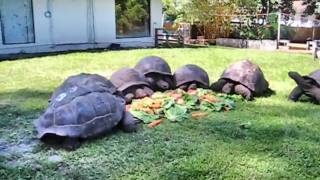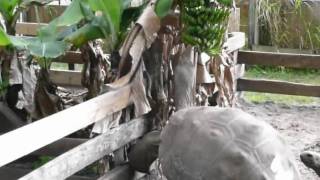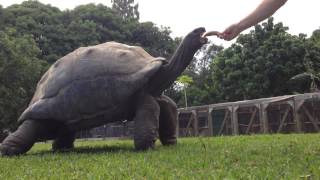Aldabra

The Aldabra Giant Tortoise (Geochelone gigantea), from the islands of the Aldabra Atoll in the Seychelles, is one of the largest tortoises in the world. This species is widely referred to as Geochelone gigantea but is now placed in the genus Dipsochelys (or sometimes in the invalid genus Aldabrachelys) as Dipsochelys dussumieri.
Aldabras Sub Adult Videos
Aldabras Sub Adult Descriptions
Taxonomy and etymology
The carapace is a brown or tan color with a high domed shape. It has stocky, heavily scaled legs to support its heavy body. The neck of the Aldabra Giant Tortoise is very long, even for its great size, which helps the animal to exploit tree branches up to a meter from the ground as a food source.
Similar in size to the famous Galapagos Giant Tortoise, its carapace averages 120 centimetres (47 in) in length. The average weight of a male is around 250 kilograms (550 lb), but one male at the Fort Worth Zoological Park weighs over 360 kilograms (790 lb). Females are generally smaller than males, with average specimens measuring 90 centimetres (35 in) in length and weighing 150 kilograms (330 lb).
Range and habitat
Sahel of Sahara Desert TortosieThe main population of the Aldabra Giant Tortoise resides on the islands of the Aldabra Atoll in the Seychelles. The atoll has been protected from human influence and is home to some 152,000 giant tortoises, the world's largest population of the animal. Another isolated population of the species resides on the island of Zanzibar, and other captive populations exist in conservation parks in Mauritius and Rodrigues. The tortoises exploit many different kinds of habitat including grasslands, low scrub, mangrove swamps, and coastal dunes.
Habitat
A peculiar kind of habitat has co-evolved due to the grazing pressures of the tortoises: "tortoise turf," a comingling of 21 species of grasses and herbs. Many of these distinct plants are naturally dwarfed and grow their seeds not from the tops of the plants, but closer to the ground to avoid the tortoises close cropping jaws.
As the largest animal in its environment, the Aldabra tortoise performs a role similar to that of the elephant. Their vigorous search for food fells trees and creates pathways used by other animals.
Feeding
Feeding ecology Primarily herbivores, Aldabra Tortoises will eat grasses, leaves, and woody plant stems. They occasionally indulge in small invertebrates and carrion, even eating the bodies of other dead tortoises. In captivity, Aldabra Giant Tortoises are known to enjoy fruits such as apples and bananas as well as compressed vegetable pellets.
There is little fresh water available for drinking in the tortoises natural habitat, therefore they obtain most of their moisture from their food.
Aldabra Giant Tortose Geochelone gigantea at Bristol Zoo, EnglandThe Aldabra tortoise has two main varieties of shell. Specimens living in habitats with food available primarily on the ground have a more dome-shaped shell with front extending downward over the neck. Those living in an environment with food available higher up off the ground have a more flattened topped shell with the front raised to allow the neck to extend upward freely.
Behavior
Aldabra tortoises are found both individually and in herds, which tend to gather mostly on open grasslands. They are most active in the mornings when they spend time browsing for food.
A herd of Aldabra tortoises at the Botantical Gardens, MahéThey dig underground burrows or rest in swamps to keep cool during the heat of the day.
While they are characteristically slow and cautious, they are capable of appreciable speed, especially when tempted with a treat. They are also known to attempt perilous acrobatic feats, rising precariously on their hind legs to reach low branches. They risk death by tipping onto their backs and being unable to right themselves.
They are also excellent swimmers, being naturally buoyant. This factor has allowed the spread and eventual speciation of many kinds of related tortoises across the Indian Ocean.
The tortoises are not domestic or tame, but they are remarkably indifferent to the presence of humans. They do not seem to have any fear of people; some even seek them out for attention. Some like to have their heads patted, others enjoy having their necks scratched where they meet their plastron.
Life History
Large tortoises are among the longest-lived animals on the planet. Some individual Aldabra Giant Tortoises are thought to be over 200 years of age, but this is difficult to verify because they tend to outlive their human observers. Adwaita was reputedly one of four brought by British seamen from the Seychelles Islands as gifts to Robert Clive of the British East India Company in the 18th century and came to Calcutta Zoo in 1875. At its death in March 2006 at the Kolkata (formerly Calcutta) Zoo in India, Adwaita is reputed to have reached the longest ever measured life-span of 255 years (birth year 1750), although the accuracy of this is disputed due to a lack of contemporary records. Today, Esmeralda is thought to be the oldest living Giant Tortoise at 170 years old, since the death of Harriet at 176, a Galapagos giant tortoise. Esmeralda is an Aldabra Giant Tortoise.
In captivity
The Aldabra tortoise is recently becoming more available in the pet trade. The price still makes them somewhat of an exclusive animal, costing between $1,000 and $20,500 depending on size as of 2006. Care for these tortoises requires a good deal of commitment. They are very powerful as adults, and can be destructive in a typical suburban setting; capable of ramming through fences and doors. Fairly expensive accommodations are necessary to contain these tortoises and keep them at a comfortable temperature throughout the year (80-95F 27-35C).
Due to their size and longevity, Aldabra tortoises sometimes figure as a prestige gift from the Seychelles government to foreign countries. A pair of these animals is to be presented by the island country to the 2010 World Expo in Shanghai in celebration of the 60th anniversary of the founding of the People's Republic of China. The two tortoises will be actually kept in Shanghai Zoo.
Breeding
Between February and May, females lay between 9 and 25 rubbery eggs in a shallow, dry nest. Usually less than half of the eggs are fertile. Females can produce multiple clutches of eggs in a year. After incubating for about 8 months, the tiny, independent young hatch between October and December.
In captivity, oviposition dates vary. Tulsa Zoo maintains a small herd of Aldabra tortoises and they've reproduced several times since 1999. One female typically lays eggs in November and again in January, providing the weather is warm enough to go outside for laying. The zoo also incubates their eggs artificially, keeping two separate incubators at 81 degrees F and 86 degrees F. On average, the eggs kept at the latter temperature hatch in 107 days.
















.jpg)
 - Copy.jpg)




































